Ocicat cat quick facts
Length: 12 - 16 inches
Weight: Females: 8 - 10 pounds, males: 10 - 12 pounds
Video of the Day
Video of the Day
Lifespan: 12 - 18 years
Coat length: Short
Coloring: Spotted coat pattern in black, black silver, blue, blue silver, chocolate, chocolate silver, cinnamon, cinnamon silver, fawn, fawn silver, lilac, and lilac silver with any eye color except for blue.
Grooming needs: Low
Friendliness: Breed alone is not an accurate predictor of individual cats' personalities. However, Ocicat cats are generally regarded as active, affectionate, and sociable.
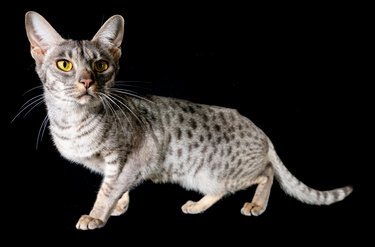
The Ocicat was named after the ocelot, a wild cat found in the southwestern United States, as well as Central and South America. Ocicats may share a similar appearance, but the breed is not related to the wild species and is a completely domestic cat breed. If you love the appearance of the wild cat and enjoy being a pet parent to an intelligent and playful cat breed, the Ocicat breed may be for you. Carefully consider the breed's personality and care requirements before deciding to bring a new kitten into your home.
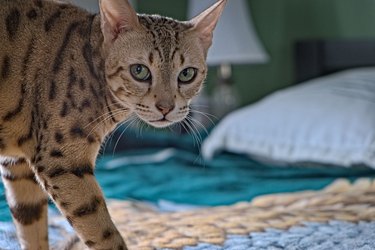
Ocicat cat history
The first Ocicat was born in 1964 in Michigan when Virginia Daly bred an Abyssinian cat with a seal point Siamese cat. She was attempting to breed an Abyssinian-pointed Siamese cat. The resulting litter included a spotted kitten, named Tonga.
Geneticist Dr. Clyde Keeler was interested in the wild appearance of the spotted cat and the breeding was repeated. This litter included a tawny spotted kitten.
The new breed of cat was named Ocicat by Virginia Daly's daughter. The breeding program continued with Abyssinian, Siamese, and American shorthair cats. In 1987, both the Cat Fanciers' Association (CFA) and the International Cat Association (TICA) granted championship status to the Ocicat breed.
This spotted cat comes in 12 different coat colors and four other coat patterns including:
- classic tabby
- pointed
- solid
- ticked
They also have a wedge-shaped head and large, almond-shaped eyes.
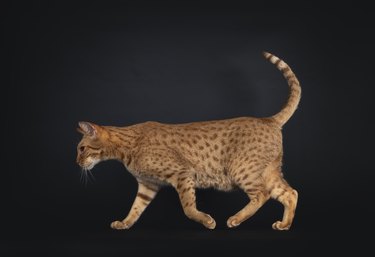
Ocicat cat personality
Ocicats are intelligent, curious, and energetic. They will explore every corner of the home and many Ocicats even like playing in water. Don't be surprised if they try to stick their paws in an aquarium, bath, or sink. The breed is very athletic and can easily climb or jump to the highest perches in the home.
Sometimes described as dog-like, the breed is also very sociable and prefers to spend their time with their human family. They may follow you around the home and tend to be quite vocal. You can teach the cats to walk on a leash and harness so that they can accompany you on outings. You can also use positive reinforcement techniques to teach them tricks and to respond to cues.
It is not uncommon for an Ocicat to select a favorite pet parent, but that doesn't mean they don't interact with other members of the family and even greet visitors to the home. If you live alone and spend long hours at work, this is not the breed for you. Another pet in the household can help to provide companionship for your cat and the breed tends to get along with both other cats and dogs.
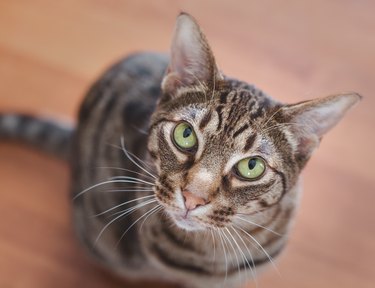
Ocicat cat lifespan & health issues
A healthy and well-cared-for Ocicat can live into their late teens. The breed tends to be quite healthy, but there are a few genetic health problems that affect the cats in rare cases. These include:
- Hypertrophic cardiomyopathy, a type of heart disease that causes a thickening of the heart wall
- Progressive retinal atrophy, an eye disease that can eventually cause blindness
- Renal amyloidosis, a disease that causes the build-up of proteins in the kidneys
Be sure to discuss the cat's health history with the breeder. Keep up with regular veterinary check-ups to catch any health concerns early and ensure your cat receives all of the recommended vaccinations.
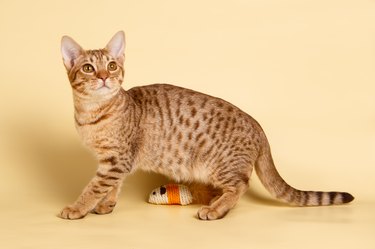
Ocicat cat grooming & care
The Ocicat's coat is satiny and short which makes grooming a breeze. Brush your cat weekly to remove any dead hair and keep the coat shiny. If your cat enjoys the process, you may want to groom them more often to deepen your bond. Additionally, check and trim your cat's nails and brush their teeth with veterinarian-approved toothpaste.
Feed high-quality cat food in the amount recommended by your veterinarian. Check the food label and select a high-protein food made with real meat. Keep fresh water available for your cat at all times.
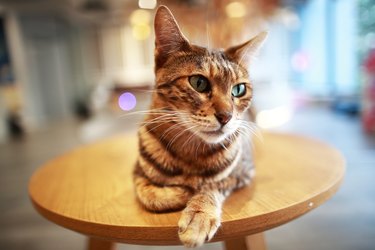
Welcoming a new cat
Before bringing your new Ocicat home, it is important to cat-proof the home. While a young kitten may stay close to the ground, it won't be long before they are climbing and jumping. When cat-proofing the house, check even the highest shelves and the top of your refrigerator to make sure there isn't anything your new cat can get into.
Select a room where you can welcome your cat and give them time to adjust to their new surroundings. Set up the area with everything your new cat will need including:
- food and water
- litter box
- cat toys
- cat tree
- scratching post
Spend plenty of time with your new cat but give them space to explore and approach you when they are ready. It is important not to rush your cat, but with a bit of patience, this sociable breed is likely to bond with you before you know it.
If you have other pets in the household, introduce them to the new cat. When your cat is comfortable with the new home and other family members, open the door and allow them access to more of the house.
Here are some other questions you might have about Ocicat cats:
What is the difference between a tabby cat and an Ocicat?
An Ocicat is a recognized cat breed. Tabby cats, on the other hand, may be any breed. Tabby refers to a coat pattern that features spots, swirls, or stripes.
Are Ocicats rare?
Ocicats are relatively rare in the United States compared to some more popular breeds, but it is possible to find reputable breeders who offer kittens. The breed is more difficult to find in other countries. You can generally expect to pay between $800 and $1,200 for an Ocicat kitten.